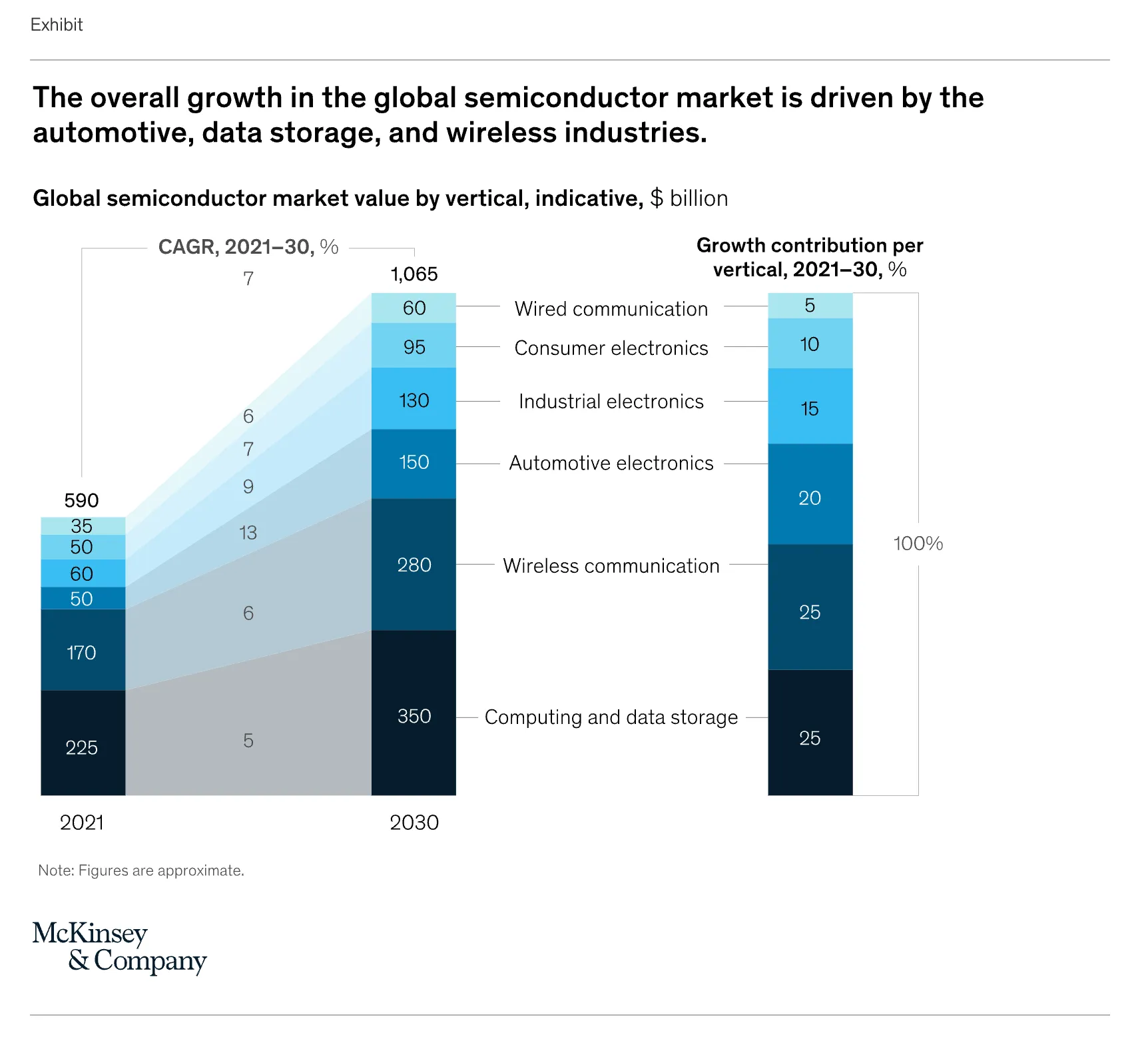This morning, the tech industry was shaken by a major announcement: the Chinese startup DeepSeek has unveiled a revolutionary AI chip that can outperform traditional GPUs on several critical fronts. Result? A spectacular fall of 16% in Nvidia shares, the main market leader, in just one day. This event marks a turning point in the history of semiconductors, as it redefines the balances in the industry and introduces a new player capable of competing with historical leaders.
In this article, we explore how these upheavals are redefining the semiconductor industry, influencing the ecosystem No-code, platforms like Webflow, and are changing the way we think about web.

Semiconductors: The backbone of digital innovation
Semiconductors are much more than just a technical component: they are the essential driver of the modern digital ecosystem. Their market, estimated at 710 billion dollars in 2025, is experiencing explosive growth, driven by critical areas such as artificial intelligence, cloud infrastructures, and immersive technologies.
Varied uses, global impacts
Semiconductors power:
- Artificial intelligence (AI) : Learning algorithms like GPT chat automatic require massive computing power to operate in real time.
- Cloud infrastructures : The latter ensure the management and availability of digital tools accessible online.
- Immersive experiences : Smooth animations and complex 3D renderings that make interactive sites engaging.
Key figure: Nearly 90% of the advanced chips needed for these uses are produced at taiwan, a dominance that makes the industry vulnerable to geopolitical tensions.
Why are they essential for web design and no-code?
Semiconductors play a key role in the success of platforms No-code And website creation tools like Webflow :
- Advanced graphic renderings
GPUs (Graphics Processing Units) are essential for generating animations, smooth transitions, and immersive user experiences. Without these chips, it would be impossible to create interfaces as captivating as those available on Webflow. - AI support
Semiconductors make it possible to operate artificial intelligence algorithms that personalize content and optimize site performance. - Cloud accessibility
Cloud infrastructures, which support no-code platforms, depend on semiconductors to provide speed, fluidity, and storage at scale.
By 2025, it is estimated that 3D renderings and interactive animations will represent nearly 45% of requests from website creators, especially on platforms like Webflow.
The geopolitical battle over semiconductors
The announcement of DeepSeek comes in a global context that is already marked by intense tensions. Les semiconductors are not only a technological challenge, but also a strategic lever at the heart of rivalries between the great powers.
Taiwan: The global semiconductor epicenter
With actors like TSMC (Taiwan Semiconductor Manufacturing Company), Taiwan produces:
- 60% of the world's semiconductors.
- 90% of advanced chips, essential for cloud infrastructures and artificial intelligence.
According to the McKinsey report “The Semiconductor Decade”, the semiconductor industry, which represented around 600 billion dollars in 2021, could reach the $1,065 billion by 2030. These figures highlight the growing importance of semiconductors in various sectors such as artificial intelligence, cloud computing and no-code platforms.

Tensions that threaten innovation
- Possible disturbances: Any escalation between China and Taiwan could seriously disrupt global supply.
- Rising costs: A prolonged crisis would lead to an increase in the prices of cloud services, indirectly affecting no-code platforms.
- Change in balances: The rise of DeepSeek shows that China is seeking to empower itself technologically, redefining power relationships in industry.
Why does this concern the web?
If semiconductor costs increase, platforms like Webflow could be forced to adapt their prices or limit access to certain advanced features.
DeepSeek: A Revolutionary Technological Breakthrough
DeepSeek is not just a startup : it marks a breakthrough in the semiconductor industry with an AI chip with revolutionary performances.
Characteristics that are shaking up the market
- 10x faster than traditional GPUs for some artificial intelligence calculations.
- One energy consumption reduced by 40%, a key advantage for data centers.
- One direct cloud compatibility, making these chips ideal for massive applications such as personalization or real-time automation.

A direct impact on no-code and Webflow
With increased performance and reduced energy consumption, DeepSeek technologies could transform the capabilities of no-code platforms:
- More immersive user experiences: 3D renderings and interactive animations could become more accessible.
- Enhanced personalization: AI-based automation could be integrated into tools like Webflow to offer suggestions or optimize designs in real time.
The parallels with the Webflow Add-On Model
In this context of dependence on semiconductors and soaring costs, Webflow is a perfect example of how platforms can adapt with flexibility and modularity.
Add-On Model Lessons
- Modularity in the face of scarcity: Just like Webflow users can add features to the map (increased CMS volumes, additional employees), the technology industry could turn to a modular offer to meet economic constraints.
- Optimization of resources: Limiting access to resource-intensive features to premium projects could become a norm in a world where semiconductors are a valuable resource.
Impacts on website creators and no-code
In 2025, creators must face a double constraint: rising costs and the rapid evolution of technologies. Here's how to adapt:
- Prioritize energy efficiency:
- Reduce unnecessary animations and heavy scripts.
- Optimize site performance to limit resource consumption.
- Investing in agility:
- Test new ideas quickly to adapt to technological developments.
- Adopt flexible tools like Webflow to meet market demands.
- Focus on AI innovation:
- Integrate artificial intelligence-based functionalities to personalize and optimize user experiences.
Conclusion: An industry at a historic turning point
The 2025 figures confirm one thing: the future of semiconductors, no-code and web design is more interconnected than ever. The tensions around semiconductors and the rise of DeepSeek mark a A key moment for the digital ecosystem. No-code platforms like Webflow must anticipate these upheavals to transform these challenges into opportunities.
Within Noqode, we believe that periods of transformation, even complex ones, are major moments of innovation. By integrating efficient tools and by anticipating market changes, we help our customers turn these challenges into growth drivers.
The future belongs to those who know how to adapt. 🚀








